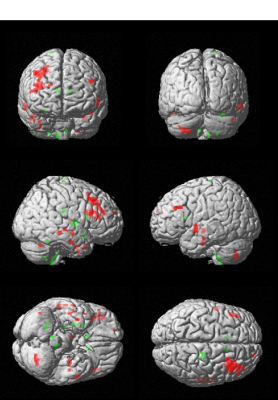4541
A comparison of audiovisual and auditory cue based gaming using fMRI1Department of NMR and MRI Facility, All India Institute of Medical Sciences, New Delhi, India, 2Dr. Rajendra Prasad Centre for Ophthalmic Sciences, All India Institute of Medical Sciences, New Delhi, India
Synopsis
Gaming involves coordination between attention, spatial processing and motor processes. In the present study, fMRI during an audio-video gaming paradigm was carried out in healthy participants (n=6, 2M, 4F, mean age=31.2 years and SD=5.58), in two sessions, with audio-only stimulus and audio-video stimuli. Data processing and inter-group comparison was done using spm12. The results suggest attention, cognitive control and learning processes during the audio-only task as compared to the audiovisual task.
Purpose
Audiovisual tasks are often preferred as compared to only auditory tasks. We have attempted to map the cognitive processes involved in coordination and spatial perception during gaming with audio and audiovisual cues.Introduction
Goal directed behavioral tasks or audiovisual audio games are associated with higher mental functions. Playing video game(s) is being used as a tool to achieve insight into cognitive processes as well as a means to improve cognitive control and recreational activities.1 A variety of gaming protocols have been designed to access different brain functions, but a very few studies have focused upon the neural mechanisms responsible for the perception of mental imagery using auditory and visual stimuli.2 The present study utilises an audio-video gaming task, notably developed for examining the mental imagery as the response to an auditory stimulus.Methodology
Healthy participants (n=6, 2M, 4F, mean age=31.2 years and SD=5.58) were recruited after obtaining a written informed consent from them. An audio video behavioral gaming paradigm was developed using the game engine UNITY (version 5.5.0f3 personal) developed by Unity Technologies (San Fransisco, U.S.A) and an executable file was used with the help of stimulus presentation system (SensaVue, Invivo corporation, M/s. Philips Health Care, The Netherlands). A task based BOLD acquisition was performed using a 3T MRI scanner (Ingenia, M/s. Philips Health Care, The Netherlands). EPI sequences were acquired in two sessions i.e. audio-only gaming session (only with the audio stimulus) and the audio-video gaming session (with video and audio stimuli), using the parameters TR=2000ms, TE=30 ms, slice thickness=4.5mm, dynamics=165. The fMRI data was processed using SPM 12 (Welcome Trust Centre for Neuroimaging, UCL, UK). The group difference between the activity with video stimulus and without video stimulus was computed by applying the paired t-test (p<0.005 and extent threshold k=5).Results
The brain activation maps, when observed for the audio-only session were found to be having the cluster maxima at the auditory association cortex (BA 41, 22) with a right cerebral dominance. The somatosensory cortex (BA 3), the premotor cortex (BA 6) and the supra marginal gyrus (BA 40) were seen to be significantly activated for both the audio-only and audio-video sessions. A group comparison of the audio-only task versus the audio-video task (Tables 1 and 2) revealed higher bihemispheric activations in the audio-only task in the frontal lobe (BA 8, 9 & 46), temporal lobe (BA 20, 21, 22 & 38) and the cerebellum.
Discussion
The BOLD activation in the somatosensory cortex, the primary motor cortex and the supramarginal gyrus observed for both the sessions may be attributed to sensory perception, motor control and the visuospatial information processing.2,3 The group comparison of the two sessions revealed a significantly higher activation in the middle frontal gyrus in the audio-only task which may be associated with motor planning, visuospatial attention and topographic memory.1 Activation clusters in the middle temporal gyrus may suggest a more pronounced use of semantic memory as well as semantic control while in the superior temporal gyrus the activations may signify the non verbal sound processing, sound intensity pitch and harmonic tone perception in the audio-only task.4 The BOLD activation in thalamus, fusiform gyrus and substantia niagra during audio-only session may be attributed to enhanced cognitive control with visualisation and memory components to assess the performance in the gaming with spatial navigation.2,5 The caudate nucleus and the lentiform nucleus activated during the audio-video task, may be ascribed to the goal-directed attention and visual rewards (game points) experienced during the session.6-8Conclusion
In the present study, the comparison between the auditory and audiovisual responses suggest enhanced activation in the areas responsible for the attention, cognitive control and learning processes during the audio-only task as compared to the audiovisual task. This approach can further be utilised for the implementation of new learning processes and to improve the control of exogenous attention as well as the mapping of complex cognitive functions for various neuropathological studies.Acknowledgements
No acknowledgement found.References
1. S Kühn, A Romanowski, et. al. The neural basis of video gaming. Transl Psychiatry. 2011;1:e53.
2. Sabrina Schenk, Robert K. Lech, Boris Suchan. Games people play: How video games improve probabilistic learning. Behavioural Brain Research;2017:335, 208–214.
3. Fang J, Hu X, Han J, Jiang X, Zhu D, Guo L, Liu T. Data-driven analysis of functional brain interactions during free listening to music and speech. Brain Imaging Behav.2015;9:162-77.
4. Nozaradan S, Schwartze M, Obermeier C, Kotz SA. Specific contributions of basal ganglia and cerebellum to the neural tracking of rhythm. Cortex. 2017; 95:156-168.
5. Ogawa A, Macaluso E. Audio-visual interactions for motion perception in depth modulate activity in visual area V3A. Neuroimage. 2013; 71:158-67.
6. Lorenz RC, Gleich T, Gallinat J, Kühn S. Video game training and the reward system. Front Hum Neurosci. 2015; 9:40.
7. Grahn JA, Parkinson JA, Owen AM. The cognitive functions of the caudate nucleus. Prog Neurobiol. 2008; 86(3):141-55.
8. Mathiak KA, Klasen M. Reward system and temporal pole contributions to affective evaluation during a first person shooter video game. BMC Neurosci. 2011;12:66.
Figures
